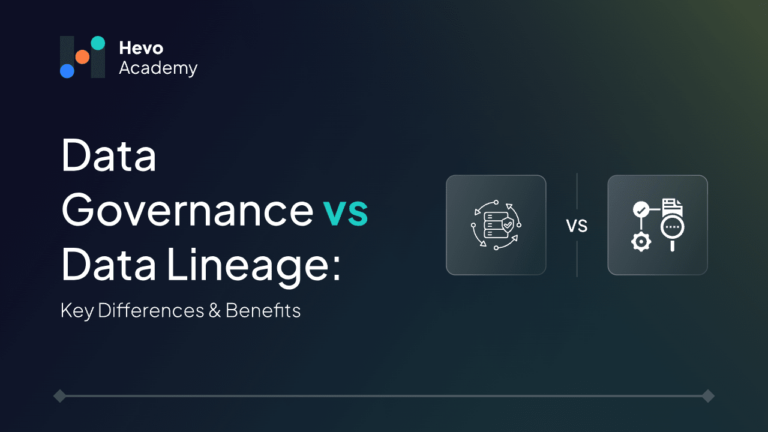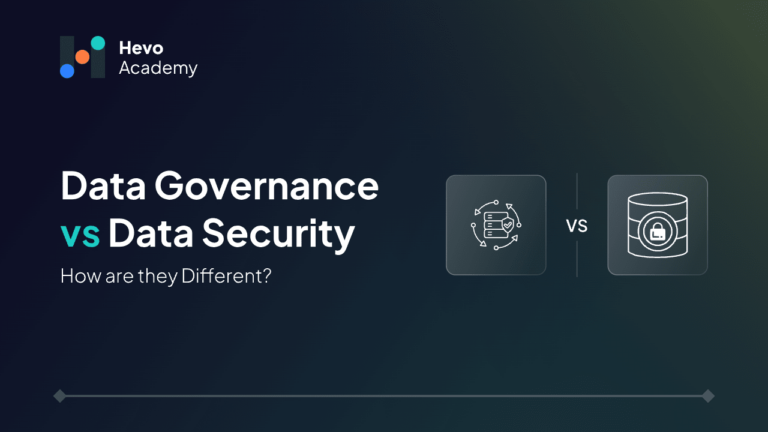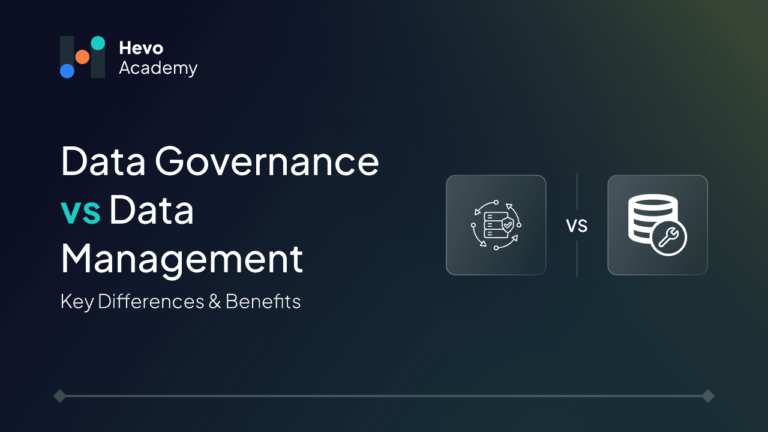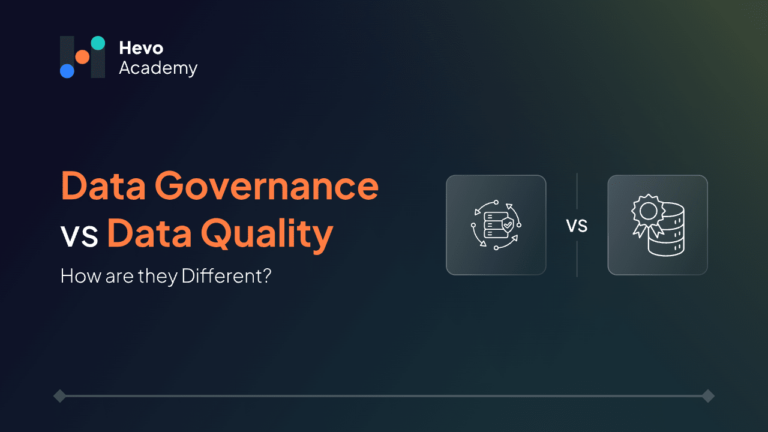In this digital age, organizations rely heavily on data to make data-driven decisions, which helps them compete in the competitive market and drive the business process smoothly. Due to the increase in the volume of data, data management has become quite a tricky and complex process.
Table of Contents
The two data concepts viz. Data Governance vs Data Lineage are very helpful in the data management strategy.
In this blog, we will explore the similarities and differences between Data Governance vs Data Lineage.
What is Data Governance?
Data governance is a framework consisting of policies and standard practices established in an organization that we should follow during the data lifecycle to ensure that the data is accurate, secure, and usable.
Data Governance provides a structural approach to handling data within an organization. Its sole purpose is to ensure that the data is accurate, consistent, and secure and that it complies with regulatory standards to avoid hefty fines and compliance issues.
Tired of manually maintain your data from multiple sources and want a one-stop solution for all your data into one destination like a data warehouse such as Snowflake, or BigQuery. Hevo, here supports 150+ sources (with 60+ free sources) with features such as:
- Seamless Integration: Consolidate data from multiple sources into one destination.
- Auto-Schema Mapping: Automatically map schemas for smooth data transfer.
- Flexible Transformations: Use simple drag-and-drop transformations or custom Python scripts.
- Real-Time Data Ingestion: Keep your data up-to-date with real-time synchronization.
Join over 2000 satisfied customers, including companies like Cure.Fit and Pelago, who trust Hevo for their data management needs. Explore our capabilities with a free personalized demo and see how you can benefit.
Get Started with Hevo for FreeKey Components of Data Governance:
- Policies and Standards: Data governance policies and regulatory standards establish the standard rules and guidelines for handling and maintaining data across the lifecycle.
- Data Ownership: Data Governance policies state that each domain should be given roles and responsibilities for data management.
- Data Quality: Maintaining the data quality to ensure that the data is accurate, complete, consistent, and ready for use.
- Data Security and Compliance: Data Security is an important aspect of Data Governance. Data Governance establishes rules and security firewalls to protect the data from unauthorized access and ensures compliance with regulatory requirements.
- Data Stewardship: Data Governance designates individuals or teams to responsibly manage data assets and enforce governance practices.
Read more about Data Governance:
- What is a Data Governance Program and How to Implement It?
- Understanding the Core Components of Data Governance
- How to Overcome Data Governance Challenges?
What is Data Lineage?
Data lineage is the process of tracking the life cycle of data as it moves across various stages in the pipeline, i.e., from ingestion to destination. The Data Lineage process traces the flow of data as it transforms. This provides a holistic view of the data, including where data comes from, how it is transformed, and how it is consumed. Organizations can have accountability and transparency in data management by having the data’s whereabouts.
Key Aspects of Data Lineage:
- Data Origin: Data Lineage identifies where the data is generated or originated.
- Transformation Processes: It tracks how the data is transformed while undergoing different transformation processes.
- Destination and Usage: Understanding where the data is going or being consumed.
- Data Dependencies: It identifies the relationships and connections between data sets and systems.
- Historical Tracking: Capturing and recording past data states and changes to understand current data context.
Data lineage helps organizations maintain transparency in their data management processes. It provides a clear picture of the data’s lifecycle, from ingestion to end-use. It also supports regulatory compliance, allowing us to trace the exact path of the data for audit purposes.
Read More about Data Lineage:
- What is Data Lineage? Types, Techniques, & Best Practices
- How to Perform Data Lineage Implementation? [+Steps, Techniques and Best Practices]
- Understanding dbt Data Lineage: A Comprehensive Guide
Data Lineage vs Data Governance
On the high level, Data Governance vs Data Lineage might look similar to you, but they have distinct functions in terms of data management. The core differences between Data Governance vs Data Lineage are as follows –
| Aspect | Data Governance | Data Lineage |
| Purpose | Data governance focuses on creating policies and standards for managing the data. Its primary goal is to ensure that the data adheres to the policies and meets the regulatory compliances. | Data lineage tracks the flow and transformations of the data from origin to destination. The main purpose of the Data Lineage is to provide visibility of the data in terms of – where data comes from, how it changes, and where it ends up. |
| Scope | Data governance encompasses a broader scope, covering data policies, security, privacy, quality, and ownership across the organization. | Data lineage focuses specifically on the journey and transformations of data, providing visibility into how data is handled at each stage. |
| Process | Data governance defines the rules and policies that should be followed in the processing of the data and it also sets the standard for the data usage. | Data lineage provides the practical, real-time tracing of how rules are being followed and how data moves through systems. |
| Compliance | Data Governance provides the policies and framework that an organization needs to follow during its data journey. | Data Lineage provides the audit trail to demonstrate that the policies set by Data Governance are followed. |
How Important is Data Lineage in Data Governance?
Data lineage plays a crucial role in Data Governance by ensuring that standard policies are successfully applied. Below are the key areas that depict the importance of Data Lineage in Data Governance-
- Enhancing Data Quality: The key goal of a Data Governance framework is that the Data should be accurate and reliable. Data Lineage provides a documented view of data movement and transformation within the organization and helps in identifying any inconsistencies or errors in data handling.
- Supports Compliance and Auditing: Data Lineage provides an audit trail of the data movement. The organizations document these audit trails to respond to regulatory requirements, such as GDPR, CCPA, and others when being approached.
- Improves Data Security: Data Lineage tracks and reveals how the data moves between different systems and applications. This lineage allows security teams to identify vulnerable points where data may be exposed or mishandled and then implement stricter controls to ensure that sensitive data is handled securely.
- Enables Better Decision-Making: Data Lineage allows the users to trace the origin and transformation of the data. This ensures that the organizations are using high-quality and trustworthy information as accuracy and Integrity of data play a pivotal role in Data-driven decisions.
- Cross-Team Collaboration: Data Lineage enables collaboration between teams by ensuring that all teams have a good understanding of how data flows through the organization.
The Benefits of Integrating Data Lineage into Data Governance
- Transparency and Accountability: Data Lineage provides the tracking of the data flow through the organizations. This transparency ensures that the data owners, stakeholders, etc are accountable for following the Data Governance policy.
- Risk Mitigation: Data lineage by tracking the data flows, helps the organization to identify the potential risks during data transformation. These risks help the organization to adhere to the Data Governance policies.
- Improved Data Access Control: In Data Governance, the policies are made in such a way that only authorized personnel should be able to access the sensitive data. Data Lineage provides insights into where sensitive data is stored and how it is handled throughout the pipeline.
- Streamlined Data Integration: Organisations deal with the huge amount of data spread across multiple systems. Data Lineage can track the flow of data from origin to destination. This helps organizations to understand how the data from different sources interact with each other and also to ensure that the policies are followed across the data ecosystem.
Overcome barriers in data traceability and impact analysis with effective solutions for data lineage management.
Conclusion
Data governance vs Data Lineage are two important processes in modern data management. Data Governance ensures that the data complies with the regulatory standards by defining the rules, policies, and roles, whereas Data Lineage provides the tracking of how data moves across the organization. These two processes are essential for any organization to build trust in the data.
By integrating data lineage within a data governance framework, organizations can achieve a higher level of data transparency, security, and efficiency.
Data migration plays a vital role in implementing a strong data governance framework. Sign up for Hevo’s 14-day free trial and experience seamless data integration without worries!
FAQs on Data Governance vs Data Lineage
What are the 5 levels of data governance?
The five levels of data governance are:
1. Initial Phase: In the initial phase, there are no formal data governance processes in place within an organization.
2. Repeatable Phase: In the repeatable phase, some data management processes exist but are inconsistent.
3. Defined Phase: In the defined phase, the formal data governance policies and procedures are documented.
4. Managed Phase: At this managed phase, the Data Governance is more mature, and robust. Governance metrics are used to track compliance and report.
5. Optimized Phase: Continuous improvement processes are applied to data governance to make it more organized within the organization.
What are the two types of data lineage?
The two types of data lineage are:
1. Physical Data Lineage: Physical Data Lineage tracks the movement of the data and the transformations between systems and databases.
2. Logical Data Lineage: Logical Data Lineage focuses on the conceptual flow of data. It represents how the business processes the data and how the data models interact with each other.
What is Data Lineage in Data Governance?
Data Governance refers to the policies and standards that are being established in an organization. Data Lineage is a part of Data Governance where it tracks the data as it moves across different systems and transformations within the organization. It provides visibility of data’s origin, flow, and transformations. These lineages provide the trail of data transformation by which we can verify the authenticity of the data.






